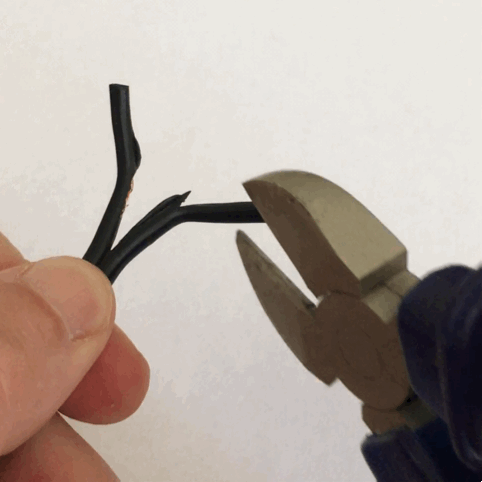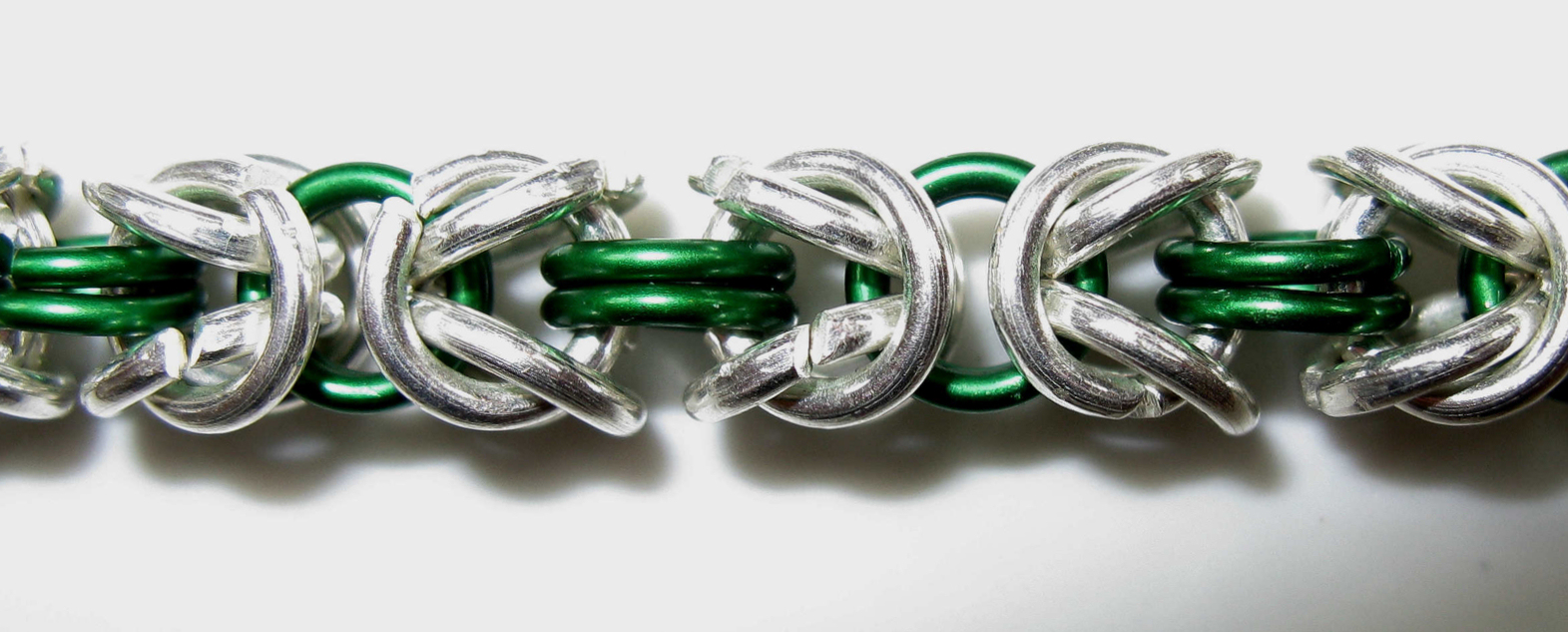|
Round-nose Pliers
Round nose pliers, often called rosary pliers in the jewelry trade, are a specialized type of pliers characterized by their jaws of approximately round cross-section, usually of smooth surface finish and diameter tapering toward the tips. Uses Round nose pliers are commonly used in electronics and electrical wiring for forming a loop at the end of a wire and in jewelry making to form a variety of bends in wire. Variations Often, round nose pliers have insulated handles for safe electrical work, a spring-fitted joint for ready opening and closing, and comfortable grips on the handles to make them easy to manipulate. Variations particularly favored by jewelers and beadsmiths include one of the jaws flat rather than round (for making chain), jaws of differing diameters or non-tapered jaws which are used to make findings such as bails, jump rings Jump rings are (usually metal) rings used to make chains, jewelry, and chain mail. They are made by wrapping wire around a mandrel to mak ... [...More Info...] [...Related Items...] OR: [Wikipedia] [Google] [Baidu] |
Pliers
Pliers are a hand tool used to hold objects firmly, possibly developed from tongs used to handle hot metal in Bronze Age Europe. They are also useful for bending and physically compressing a wide range of materials. Generally, pliers consist of a pair of metal first-class levers joined at a fulcrum positioned closer to one end of the levers, creating short ''jaws'' on one side of the fulcrum, and longer handles on the other side. This arrangement creates a mechanical advantage, allowing the force of the grip strength to be amplified and focused on an object with precision. The jaws can also be used to manipulate objects too small or unwieldy to be manipulated with the fingers. Diagonal pliers, also called side cutters, are a similarly-shaped tool used for cutting rather than holding, having a pair of stout blades, similar to scissors except that the cutting surfaces meet parallel to each other rather than overlapping. Ordinary (holding/squeezing) pliers may incorporate a s ... [...More Info...] [...Related Items...] OR: [Wikipedia] [Google] [Baidu] |
Electrical Wiring
Electrical wiring is an electrical installation of cabling and associated devices such as switches, distribution boards, sockets, and light fittings in a structure. Wiring is subject to safety standards for design and installation. Allowable wire and electrical cable, cable types and sizes are specified according to the circuit operating voltage and electric current capability, with further restrictions on the environmental conditions, such as ambient temperature range, moisture levels, and exposure to sunlight and chemicals. Associated circuit protection, control, and distribution devices within a building's wiring system are subject to voltage, current, and functional specifications. Wiring safety codes vary by locality, country, or region. The International Electrotechnical Commission (IEC) is attempting to harmonise wiring standards among member countries, but significant variations in design and installation requirements still exist. Wiring codes of practice and regulat ... [...More Info...] [...Related Items...] OR: [Wikipedia] [Google] [Baidu] |
Rosary Beads Closeup
The Rosary (; la, , in the sense of "crown of roses" or "garland of roses"), also known as the Dominican Rosary, or simply the Rosary, refers to a set of prayers used primarily in the Catholic Church, and to the physical string of knots or beads used to count the component prayers. When referring to the prayer, the word is usually capitalized ("the Rosary", as is customary for other names of prayers, such as "the Lord's Prayer", and "the Hail Mary"); when referring to the prayer beads as an object, it is written with a lower-case initial letter (e.g. "a rosary bead"). The prayers that compose the Rosary are arranged in sets of ten Hail Marys, called "decades". Each decade is preceded by one Lord's Prayer ("Our Father"), and traditionally followed by one Glory Be. Some Catholics also recite the " O my Jesus" prayer after the Glory Be; it is the most well-known of the seven Fátima prayers that appeared in the early 20th century. Rosary prayer beads are an aid for saying these ... [...More Info...] [...Related Items...] OR: [Wikipedia] [Google] [Baidu] |
Electrical
Electricity is the set of physical phenomena associated with the presence and motion of matter that has a property of electric charge. Electricity is related to magnetism, both being part of the phenomenon of electromagnetism, as described by Maxwell's equations. Various common phenomena are related to electricity, including lightning, static electricity, electric heating, electric discharges and many others. The presence of an electric charge, which can be either positive or negative, produces an electric field. The movement of electric charges is an electric current and produces a magnetic field. When a charge is placed in a location with a non-zero electric field, a force will act on it. The magnitude of this force is given by Coulomb's law. If the charge moves, the electric field would be doing work on the electric charge. Thus we can speak of electric potential at a certain point in space, which is equal to the work done by an external agent in carrying a unit of positiv ... [...More Info...] [...Related Items...] OR: [Wikipedia] [Google] [Baidu] |
Spring (device)
A spring is an elastic object that stores mechanical energy. In everyday use the term often refers to coil springs, but there are many different spring designs. Modern springs are typically manufactured from spring steel, although some non-metallic objects like the bow are also springs. When a conventional spring, without stiffness variability features, is compressed or stretched from its resting position, it exerts an opposing force approximately proportional to its change in length (this approximation breaks down for larger deflections). The ''rate'' or ''spring constant'' of a spring is the change in the force it exerts, divided by the change in deflection of the spring. That is, it is the gradient of the force versus deflection curve. An extension or compression spring's rate is expressed in units of force divided by distance, for example or N/m or lbf/in. A torsion spring is a spring that works by twisting; when it is twisted about its axis by an angle, it produces a ... [...More Info...] [...Related Items...] OR: [Wikipedia] [Google] [Baidu] |
Finding (jewelcrafting)
Jewellery findings are the parts used to join jewellery components together to form a completed article.Dorothy Wood The Knotting & Braiding Bible: The Complete Guide to Creative ...2014 - 1446362779 "Basic jewellery findings : These are the basic components of many styles of jewellery. All findings are now available in a range of different metallic finishes including antique, so choose the most suitable colour to match or contrast with your ..." List of findings * Clasps to complete necklaces and bracelets * Earwires to link an earring to the wearer's ear * Ring blanks for making finger rings * Bails, metal loops, and jump rings, for completing jewellery. Jump rings can be used by themselves for chains * Pin stems and brooch assemblies * Tuxedo stud findings, letters of the alphabet, cluster settings, metal beads and balls * Plastic, fabric or metal stringing material for threading beads Findings are available in all the jewellery metals—sterling silver, plated silver ... [...More Info...] [...Related Items...] OR: [Wikipedia] [Google] [Baidu] |
Bail (jewelry)
A bail (also spelled "bale") is a component of certain types of jewelry, mostly necklaces, that is used to attach a pendant A pendant is a loose-hanging piece of jewellery, generally attached by a small loop to a necklace, which may be known as a "pendant necklace". A pendant earring is an earring with a piece hanging down. Its name stems from the Latin word ... or stone. The bail is normally placed in the center of the necklace where the pendant hangs. Some bails are made so a pendant can be attached after the necklace production is completed. This way, a necklace design can be mass-produced for multiple companies and the pendants can be attached after the necklaces are shipped to them. A classic bail allows the chain to pass through and is connected by a ring to the pendant. Bails are a frequently pre-made component used on an otherwise handmade piece of jewelry. A pendant can also be made with a "hidden bail." A hidden bail is typically connected to the back of a ... [...More Info...] [...Related Items...] OR: [Wikipedia] [Google] [Baidu] |
Jump Rings
Jump rings are (usually metal) rings used to make chains, jewelry, and chain mail. They are made by wrapping wire around a mandrel to make a coil, then cutting the coil with wire cutters to make individual rings. The rings can be assembled one by one into chains, earrings, objects such as bowls or ornaments, and chain mail clothing. The making of items from jump rings is called ''chain maille'' ("''maille''" is French for "''mesh''"). Jump rings can be described by the following qualities: {, class="wikitable" , Gauge , The thickness of the wire the ring is made from. Measured according to American wire gauge standards, SWG (standard wire gauge), or in millimetres. , - , Inner diameter , Approximately the same as the outer diameter of the mandrel used to create the rings, but the exact inner diameter will depend on the degree to which the wire springs as it comes off the mandrel. , - , Kerf width , The gap between the ends of the jump ring created by the cutting process , ... [...More Info...] [...Related Items...] OR: [Wikipedia] [Google] [Baidu] |
Fastener
A fastener (US English) or fastening (UK English) is a hardware device that mechanically joins or affixes two or more objects together. In general, fasteners are used to create non-permanent joints; that is, joints that can be removed or dismantled without damaging the joining components. Welding is an example of creating permanent joints. Steel fasteners are usually made of stainless steel, carbon steel, or alloy steel. Other alternative methods of joining materials include: crimping, welding, soldering, brazing, taping, gluing, cement, or the use of other adhesives. Force may also be used, such as with magnets, vacuum (like suction cups), or even friction (like sticky pads). Some types of woodworking joints make use of separate internal reinforcements, such as dowels or biscuits, which in a sense can be considered fasteners within the scope of the joint system, although on their own they are not general purpose fasteners. Furniture supplied in flat-pack form often uses c ... [...More Info...] [...Related Items...] OR: [Wikipedia] [Google] [Baidu] |



.jpg)


_arp.jpg)

